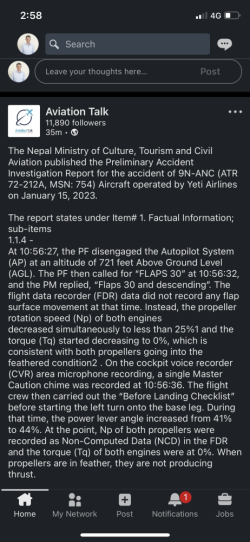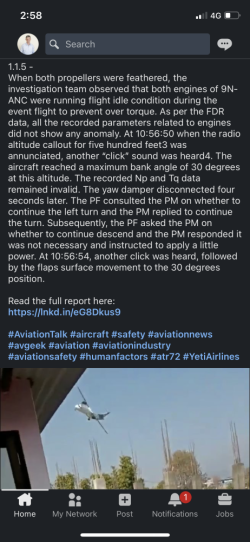Amazing the passengers didn't' realise how close it was to disaster and have a flood of social media etc at the time.
Which really fits in with my comment about the last event. The passengers are unlikely to have the slightest idea at the time, though the proximity of the media tends to bring all sorts of imagination to the fore.
Yes, very different. In this case (if it turns out to be true), microbursts are incredibly powerful and have been known to bring down jetliners before.
It’s difficult to say exactly what happened, as the FR24 data is somewhat selective in what it tells you. Ground speed and vertical speed are really the output in this equation. Wind speed and direction, IAS, and pitch attitude are input, and without them you can reach a conclusion that’s 180º out from what happened.
For instance, a very (VERY) strong tail wind, coming in over a short period of time, could give you the increase in g/s and sink that we see, whilst at the same time the pilots may have had the aircraft pitched up as far as possible, power at full, and IAS decaying. Conversely, letting the nose drop a few degrees whilst at the clean-up stage would give the same readings. One is a great save, the other is not.
The QR pilot should have chosen a better time to practice his skills, IMO. I like having a hand fly and will do so up into the high teens. But I choose the captains I do it with, the time of day, the weather conditions, the complexity of the departure, etc.
One of the indicators of a poor (or perhaps inexperienced) pilot is the inability to pick the right time.
I don’t want to load them up unnecessarily.
This possibly needs some explaining. During many phases of flight, but especially the early part of a departure, there are many things happening, either at the same time, or in quick succession. There’s the obvious, of multiple pitch and speed changes, clean up, probable low altitude restrictions. For the most part, the pilot flying takes care of all of that. The support pilot watches to make sure they all happen, enacts the calls for configuration and power changes, and takes care of ATC. That, in turn can lead to head down moments in the FMC whilst their instructions are converted to something useful. The more ‘other’ stuff that the support pilot has to do, the less time he has to keep an eye on exactly what is going on with the aircraft. The mark of a good/experienced support pilot is not just the ability to this ‘other’ stuff, but keeping the priorities in the correct order. This can mean giving ATC an ‘unable’ response, or perhaps asking/telling the flying pilot for the a/p. Conversely, a pilot who is manually flying, will often engage the a/p if he sees his support becoming overloaded.
You want two pairs of eyes watching the flight path and configuration. As you load up the support pilot with extraneous duties, his eyes disappear for increasing amounts of time. The autopilot is effectively its own pair of eyes, and the PF can keep an eye on it. That releases the support pilot to a less direct monitoring role. This is exactly how most emergency checklist items are carried out. In as much as possible, you don’t want to be manually flying whilst trying to complete a checklist.
As for the passengers, if it was night time, they would have just felt a really rough ride. It seemed to be over very quickly looking at the data. They definitely would have felt the pressure from the 2.7g (again unverified) the pilots pulled, though.
Another reason I’d like to see the IAS trace. If they’d lost a bunch of IAS due to increasing tailwind, you’d wonder how they had enough performance to hit that much g.

















